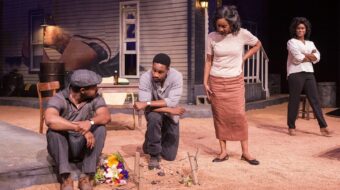
Los Angeles in the 1960s was a mecca for musical talent. Performers from many ethnic backgrounds were finally arriving at the forefront with exciting new styles and sounds. Redbone, a band consisting of four Native American musicians, officially formed in 1969, but their journey began many years earlier. Redbone: The True Story of a Native American Rock Band is a new graphic novel that relates a compelling story extending much farther than solely rock music.

Rock ’n roll enthusiasts may fondly recall Redbone’s 1974 hit, “Come and Get Your Love,” which spent 18 weeks in the Top 40 in the U.S. and peaked at number five. Featured in the movie Guardians of the Galaxy, to this day, it is a popular track on oldies stations. Readers will learn Redbone was an all-Native American band determined to stand proudly for the causes of diversity and civil rights.
The origin of Redbone began with Pat and Lolly Vasquez, brothers of Yaqui, Shoshone, and Mexican descent. The siblings adopted the stage names of Pat and Lolly Vegas in 1962 at the urging of their manager, who thought their true ethnicity would not sell at the clubs where he arranged bookings. By the end of the decade, however, the brothers were proudly embracing their heritage as civil rights took center stage.
Redbone the book enlightens readers both musically and culturally. Classic rock fans will revel in illustrations colorfully portraying Pat and Lolly Vegas sharing the bill with and befriending Jimi Hendrix and The Doors on the Sunset Strip in Los Angeles. In fact, Hendrix helped plant the seed that led to the formation of Redbone. The term “redbone” is Cajun slang for a person of mixed race ancestry—something the Vasquez brothers were very proud of. Hendrix himself, as portrayed in the graphic novel, reveals to the brothers that his grandmother was of Cherokee descent. (The book falls under the literary category of “graphic novel,” however, it’s not a fictional work, but rather the collective biography of a band.)
The graphic novel shares the story of how the remaining Native American band members, drummer Pete DePoe, and singer-guitarist Tony Bellamy, arrived to form the first incarnation of Redbone in 1969. Pete DePoe grew up on the Makah Reservation in the State of Washington. Sadly, at age ten, DePoe was sent to an assimilationist school which sought to suppress his Native American heritage and integrate the young boy into white society. Redbone pulls no punches describing the outright racism Native Americans faced throughout centuries in North America. A short history of the appalling mission of the assimilation schools, which readers may not have realized, is grimly detailed within. Quoting Pat Vegas from the book, “All the issues still plaguing us today, especially on reservations, stem from that ethnocide.”
From the outset, Redbone considered itself as much a part of a movement as a band. In the early 1970s, Redbone was a huge supporter of the American Indian Movement (AIM). Readers will learn that a majority of Redbone’s early proceeds went toward helping fund AIM. Redbone is as educational as it is entertaining. Therein lies the underlying value of the graphic novel format based on historical fact.
The formation of AIM in Minneapolis in 1968 is explained. One of the first priorities of AIM, as depicted, was gathering evidence of racist incidents by filming police abuses towards Native Americans. At that time in Minneapolis, local police often targeted and harassed Native Americans, an issue that remains extremely relevant today within many ethnic communities. Also, the horrifying 1890 Wounded Knee Massacre and the 1973 standoff by AIM and the Oglala Lakota at Pine Ridge Reservation in South Dakota are graphically shown. Furthermore, the book boldly points to recent government failures concerning the pipeline at Standing Rock, linking the struggles in the past to the 21st century.
Redbone carried on well into the 1970s, bravely standing up for social justice through their music. Although the original lineup changed throughout the years, the mission of the band never wavered. Redbone explains the origins of some of the band’s politically inspired songs, including “Alcatraz,” “Chant: 13th Hour,” and “Wovoka.” In support of the occupiers at the Wounded Knee incident in 1973, Redbone recorded “We Were All Wounded at Wounded Knee,” co-written by Pat Vegas and Sandy Baron. The song was widely banned in the United States due to its controversial lyrics, but the graphic novel details how it became a huge hit in Europe. Though the song was number one in the Netherlands for five weeks, Redbone was threatened with concert cancellations if they attempted to perform the song live at American venues.
Redbone: The True Story of a Native American Rock Band, published by IDW, was written by Christian Staebler and Sonia Paolini with the cooperation of the Vegas family. The illustrations were created by Thibault Balahy. The book is available in both English and Spanish language versions from the publisher. Many will approach this material based on classic rock interests. The fine writing and artwork will certainly lure music fans. However, much more lies within its pages to be discovered by readers, both culturally and politically.
As Redbone proclaims, referring to the post-World War II era: “The first struggle over Native American rights coincided with the birth of Redbone. The current fight is a continuation of the struggles from the ’60s. An entire people have woken up.”
Redbone: The True Story of a Native American Rock Band
By Sonia Paoloni and Christian Staebler
Illustrated by Thibault Balahy
Published by IDW Publishing (Penguin Random House)
$19.99 paperback
ISBN 9781684057146

MOST POPULAR TODAY


Zionist organizations leading campaign to stop ceasefire resolutions in D.C. area

High Court essentially bans demonstrations, freedom of assembly in Deep South

Communist Karol Cariola elected president of Chile’s legislature

Afghanistan’s socialist years: The promising future killed off by U.S. imperialism






Comments